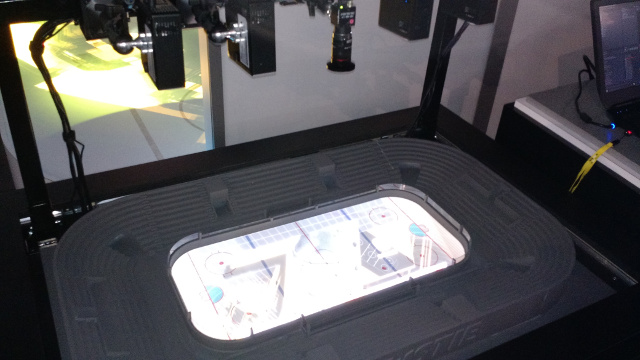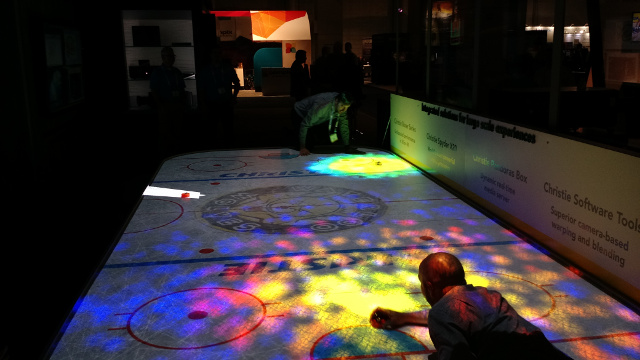Christie’s booth at InfoComm was similar to the one at NAB with a large interactive projection mapping application and supporting demo station. But it also introduced a new tool kit for this application called Mystique that is intended to make designing projection mapping application easy.
Christie’s Jeevan Vivegananthan gave a nice presentation on the projection mapping market and this new Mystique tool kit at Display Summit (Mapping Getting Easier says Christie). In the Christie booth, we had a chance to see some of the menu screens and design capabilities in person. It looks to be quite intuitive and an easy to use tool which will help to demystify the projection mapping design – which can be quite daunting. Christie will offer the tool kit to qualified integrators or as a service for them.
Mystique is intended to support the design, installation, and operation of sports venues and other Location-Based Entertainment (LBE) venues and attractions. It includes tools for system design, pre-visualization, including Virtual Reality technology and 3D printed scale model systems, camera-based alignments and system-level monitoring.
The tool kit is broken into three main components: Design, Deliver and Operate. The Design module was demonstrated to us in the booth by showing a hockey arena example where the goal is to place images only the ice surface using blended projectors. The tool allows you to choose the type, number and location of Christie projectors, including lenses, and give an output of the light coverage of these units (see photo). This enables the designer to optimize the light as needed to get the desired image quality (brightness, contrast, etc.) The tools can then simulate what the camera-based alignment and blending components will do with these image components. The result is an image that is confined to the ice and that has no visible blend zones. The designated content can even be played back in this simulation.
Want to go one step further? Christie or some other service provider can actually 3D print a scale model of this arena and the designer can then use pico projectors and a tiny camera to build a scale model of the solution to show the client. One can even don VR headgear to visualize the projection mapping if desired (I did not find this very compelling because of the low resolution of the headset).

Christie also has the tools to help with the Install and Operate phases of the project. This includes a host of existing camera-based warp and blend tools that are ideal for aligning everything from simple stacked projection deployments, to multi-projector domes, to complex 3D objects. Mystique also helps define the playback channels to ensure that content providers correctly render the highest quality content for their production with minimal warping required.
Christie has network operating centers that it uses to monitor cinema projector operation and other networks, so adding projection mapping venues to the mix should not be a big deal. This can now enable monitoring of projection mapping applications in theme park dark rides, sports stadiums and arenas by monitoring “system-level” metrics that can’t typically be monitored by individual projector monitoring tools.
Christie Mystique Design and Install will be rolling out in the fall of 2016, with Mystique Operate planned for the first half of 2017.
The second piece of new from InfoComm was the launch of the AP series of 3LCD projectors. The Christie LW502 (WXGA) and Christie LWU502 (WUXGA) deliver 5000 lumens with different contrast levels. The LW502 delivers 5,000:1 and LWU502 offers up to 10,000:1 contrast ratio.
HDBaseT (HDBT) single-cable connectivity for both digital signal and control is included in these lamp-based models that offer a lamp lifetime of 6000 hours.
Christie’s AP Series also includes edge blending, warping, DICOM simulation and an optional wireless adapter for connecting wirelessly to a LAN and showing presentations from a remote computer. The units ship in the summer of 2016.


Finally, Christie revealed a new high bandwidth plug in module for their popular Boxer series of projectors. Called HDMac, it fits into one of the slots on the projector offering 12 Gbps SDI connection, DisplayPort 1.2, HDMI 2.0 or SFX fiber quad connector which can support transport at up to 40 Gbps! This means content that is 4K, 120 fps and 4:4:4, 10 bit can easily be supported.
Christie says this is the only projector with a direct fiber input. – CC

